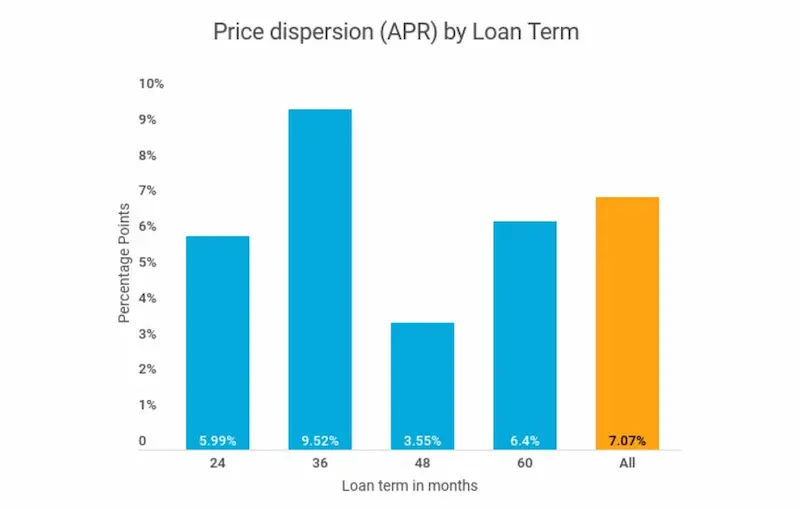APR, or Annual Percentage Rate, is the interest you’ll pay on your mortgage annually, expressed as a percentage of the loan balance. It includes the interest rate plus other charges or fees. For example, if you have a $100,000 mortgage with a 4% interest rate, your annual interest expense would be $4,000 or $333 monthly.
Your monthly mortgage payment is mostly interest in the early years of your loan, so your mortgage balance will stay relatively high even as you make payments. In the later years, your monthly payments will include more principal, so your mortgage balance will go down.
The APR is a good way to compare the total cost of different loans, loan terms, and the closing costs of each option. The APR is higher than the interest rate because it includes the fees charged by the lender, such as origination fees, and any discount points you paid to get a lower interest rate. Additionally, considering your Credit Score and the financial institution you choose can significantly impact your loan offer and yearly rate.
How Is APR Calculated?
The APR includes:
- The interest rate.
- Any points or origination fees.
- Any other fees that may apply
- Additional costs
To calculate the APR, divide the interest rate by the number of days in the year, then multiply by the loan amount. This will give you an interest charge for one year. Add to this any points, origination fees, and any other fees they may charge, along with any additional costs, and you have the APR.
For example, let’s say you take out a $100 loan at an interest rate of 6%. The number of days in a year is 365. The interest charge for one year would be $6,000. If there are no other fees or additional costs, the APR would be 6%.
However, if there are points or origination fees, they will increase the APR. For example, if 2 points, or $2,000, are charged at closing, the APR would be 8%. Also, remember to include any additional costs that may apply when calculating the APR.
The APR is a significant number to consider when taking out a loan. It will give you an idea of the actual loan cost and help you compare different loans.
APR vs. Annual Percentage Yield (APY) and Balance Transfer
The APR, or annual percentage rate, is the interest rate charged on a loan, expressed as a percentage of the loan amount. The APY, or annual percentage yield, is the effective interest rate earned on an investment, expressed as a percentage of the amount invested. APR is most commonly associated with credit cards and balance transfer offers.
The two rates are similar, but the key difference is that the APR includes the effect of compounding, while the APY does not. Compounding occurs when interest is earned on previously earned interest, so the effective interest rate is higher than the stated interest rate.
For example, if a loan has an APR of 5%, that 5% is applied to the loan’s principal each year. The interest earned in the first year is added to the loan balance. In the second year, interest is charged on the new loan balance, which includes the interest earned in the first year. This results in an effective interest rate of 5.25% in the second year.
Credit card companies often use APR to determine the cost of borrowing on credit cards. Your credit history plays a significant role in determining your credit card APRs. By understanding the difference between APR and APY, consumers can make better decisions when choosing and using credit cards, especially for balance transfers.
The APR considers compounding, so it is always higher than the APY. The APR is the more accurate measure of the true cost of borrowing, while the APY is a more precise measure of the actual return on investment.
Why Is the Annual Percentage Rate (APR) Disclosed?
When you’re considering taking out a loan, the first thing you want to know is how much it will cost you. The annual percentage rate (APR) is the annualized interest rate you charge on a loan. In other words, it’s the interest you pay each year, expressed as a percentage of the loan amount.
Federal law requires lenders to disclose the APR when they advertise loans. This allows you to compare the costs of different loans and choose the one that’s right for you, whether from credit card issuers or other lending institutions.
The APR includes the interest rate and any fees charged for the loan. This makes it an accurate measure of the cost of borrowing. For example, a loan with a low-interest rate but high fees could have a higher APR than a loan with a higher interest rate but no fees. Borrowers can also encounter different types of APR, such as the introductory rate on new credit cards or the variable rate on mortgages, which change according to the prime rate. Annual rates should always be considered when evaluating the cost of a loan to make an educated decision.
When comparing loans, look at the APR, not just the interest rate. The APR will give you a better idea of the actual cost of borrowing.
What Is a Good APR?
The APR is the best way to compare different loans because it considers all borrowing costs. A good APR is lower than the average APR for loans of the same type.
Comparing offers from different lenders would be best to get a good APR. It is also essential to have good credit to qualify for the best rates. You can get a free copy of your credit report from each of the three major credit bureaus every year.
If you are looking for a loan, ask about the APR and compare it to other offers you may receive. A lower APR can save you a lot of money over the life of the loan.
Most payday loans will stay on your credit report for 2 years from the date the loan was first reported or taken out. However, that timeframe can be longer if the payday loan goes into collections due to non-payment. Collections can remain on your report for 7 years.
Fixed APR vs. Variable APR, What is The Difference?
There are two main types of APR: fixed and variable. As their names suggest, the main difference between the two is that a fixed APR stays the same throughout the life of the loan, while a variable APR can change.
A fixed APR is often preferable for borrowers because it provides stability and predictability. You’ll always know how much your monthly payments will be, making it easier to budget the loan; a fixed APR may be lower than a variable APR. Moreover, having a fixed APR also means that you usually have a set grace period for making payments without incurring interest, simplifying managing your outstanding balance.
However, a variable APR can also have its advantages. For one, it may start lower than a fixed APR and then increase over time, meaning you’ll save money in the short term. Additionally, a variable APR can sometimes offer discounts or other perks that a fixed APR doesn’t. These perks may include benefits like reduced late payment fees or a higher credit limit during the loan’s introductory period.
Ultimately, the best type of function APR for you depends on your circumstances and the time you need the loan for. A fixed APR is the way to go if you prefer predictability and stability. However, if you’re willing to take a bit of a risk for the potential of lower payments on time, a variable APR may be the better option.
Below are some statistics on the average APR for different types of loans:
| Loan Type | Average APR |
|---|---|
| Credit card | 16.16% |
| Personal loan | 14.13% |
| Mortgage | 5.24% |
| Auto loan | 5.56% |

What Are the Different Types of Functions for APRs?
Introductory or Promotional APR:
This is the lowest possible APR the lender offers for a specific time. If you don’t qualify for this type of function for APR, you won’t be able to get the loan or use other credit products the lender offers.
Penalty APR:
This APR applies only if you miss or make an incomplete payment. It’s designed to encourage timely payments so the lender can avoid charging additional fees for those not paying their credit products on time.
Cash Advance APR:
This type of function for APR applies when you use your credit card to obtain cash. The rate is usually higher than other functions for APRs, and interest begins accruing immediately, making it essential to make payments on time.
This APR is typically used for payday, car title, and personal loans. The APR is usually higher than the introductory APR because it covers the upfront cash advance fee.
Purchase APR:
This is what most people think of when they hear “APR.” It’s the amount you pay per month on a loan.
Daily balance is the sum of the daily remaining unpaid balance for each day in the billing cycle. To calculate your purchase APR, input values like the total amount borrowed divided by the number of months in the loan. If you borrow $1,000 for 30 months, your purchase APR would be 30/360.
It’s okay to have a high purchase APR. Many consumers choose to finance large purchases like cars with a high purchase APR because it makes the overall cost of funding more affordable. However, maintaining a good credit file and paying the balance on time can help you get better loan offers. The term annual percentage rate is also a crucial factor to consider when comparing different loans.
Frequently Asked Questions
What is APR, and how does it differ from the interest rate?
APR, or annual percentage rate, represents the total cost of borrowing including interest and fees. It is higher than just the interest rate because it includes charges and costs.
How is APR calculated, and why is it important for borrowers?
APR is calculated by adding interest, fees, and costs and factoring in compounding interest over the full loan term. It provides the real annual cost of borrowing.
Can you explain the significance of APR when comparing different loan offers?
APR allows you to accurately compare the true cost of borrowing between loans, since it includes all fees and charges that can vary between lenders.
Are there any factors that can affect the APR on a loan or credit card?
Credit score, loan amount, loan term, origination fees, interest rate type, and other borrower qualifications like income can all affect the APR.
How does APR impact the overall cost of borrowing money over time?
The higher the APR, the greater the total interest and costs paid over the full loan term. Minimizing APR saves money.


